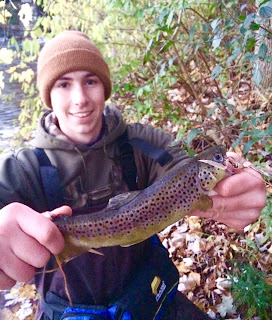Fall Browns
by Joe Settineri
It’s a crisp thirty-five degrees out, and remnants of a morning snow still lie on the ground. Dry leaves tumble and spin in the breeze while the river flows quickly. It’s late October, the perfect time for being outside and enjoying the cool, clear weather. Even better, it's a great time to trout fish. Specifically, it’s a great time to fish for Brown Trout, which is the most prolific species here in Central NY.
I called up my buddy, “You wanna fish this afternoon?”,
“Sure.” He says a little cautiously, “It's pretty cold out,” he adds.
“Alright, I’ll see you at four,” I say confidently, talking him into the cold endeavor.
In the summer when I trout fish with my friend, we wear shorts and sandals, wading through the refreshing, cool streams with the sun beating down on us. Now that it is October, things are different. The water temperature has plummeted, and the air around us is cold as well. If we wore shorts now, we would get hypothermia. Our target today is the “Big T”, or the Tioughnioga River for people who can actually pronounce it. We park in Homer and put on our waders, which protect us from the cold water. Walking to the river we look like penguins, but it all makes sense when the frigid liquid presses against our legs but does not get us wet. During this time of the year when the weather gets colder, the water also gets colder, which makes the trout more active.
One thing that makes trout fishing in the fall fun is that the trout are getting ready to spawn, and therefore, become more colorful. The shades of orange on a fall trout are something that just can't be captured with a camera. Almost immediately I hook into one, and it’s tiny. I get laughed at, but it's a start. We continue on and my friend Logan catches one, about the same size as mine. The sun begins to dip below the horizon, and we have probably walked about a mile upstream. Logan has caught five trout, and I have just caught one. Maybe I’m just bad at fishing, or I need to change the color lure that I have on. It’s seven o’clock now, and it's too dark to fish. Cold and a little wet, we start the long walk back to the truck. In my creel I have two trout, both are Logan’s. It was not a good day for me, but I still had a blast. There is nothing like a grilled fall trout.








